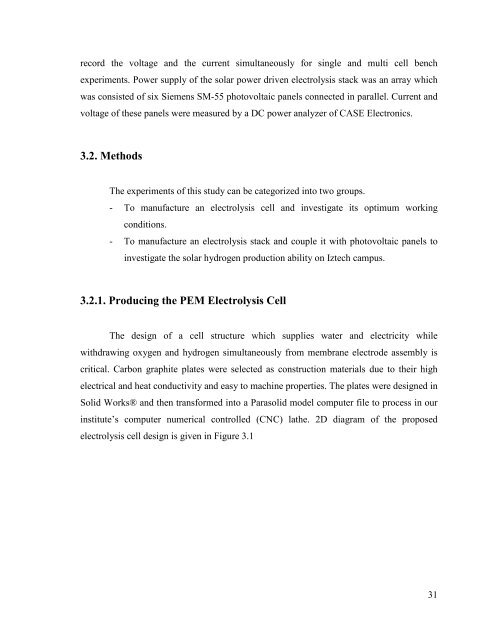hydrogen production from water using solar cells powered nafion ...
hydrogen production from water using solar cells powered nafion ...
hydrogen production from water using solar cells powered nafion ...
Create successful ePaper yourself
Turn your PDF publications into a flip-book with our unique Google optimized e-Paper software.
ecord the voltage and the current simultaneously for single and multi cell bench<br />
experiments. Power supply of the <strong>solar</strong> power driven electrolysis stack was an array which<br />
was consisted of six Siemens SM-55 photovoltaic panels connected in parallel. Current and<br />
voltage of these panels were measured by a DC power analyzer of CASE Electronics.<br />
3.2. Methods<br />
The experiments of this study can be categorized into two groups.<br />
- To manufacture an electrolysis cell and investigate its optimum working<br />
conditions.<br />
- To manufacture an electrolysis stack and couple it with photovoltaic panels to<br />
investigate the <strong>solar</strong> <strong>hydrogen</strong> <strong>production</strong> ability on Iztech campus.<br />
3.2.1. Producing the PEM Electrolysis Cell<br />
The design of a cell structure which supplies <strong>water</strong> and electricity while<br />
withdrawing oxygen and <strong>hydrogen</strong> simultaneously <strong>from</strong> membrane electrode assembly is<br />
critical. Carbon graphite plates were selected as construction materials due to their high<br />
electrical and heat conductivity and easy to machine properties. The plates were designed in<br />
Solid Works® and then transformed into a Parasolid model computer file to process in our<br />
institute’s computer numerical controlled (CNC) lathe. 2D diagram of the proposed<br />
electrolysis cell design is given in Figure 3.1<br />
31

















